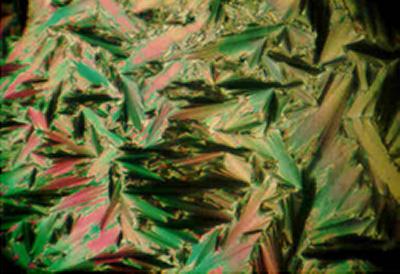Research project: Liquid Crystals and Classical Optics
Liquid crystals, their optical properties and classical optics
Liquid crystals, their optical properties and classical optics

Physics textbooks normally identify as the three phases of matter, the solid, liquid and vapour phases. Liquid Crystals are a different state of matter which exhibit a degree of order between that of a fluid and a solid: its molecules are not in a fixed position, as is the case of liquids, but may have very similar orientations, as is the case of crystals. The average orientation of the liquid crystal molecules as a function of position is called the director field. Liquid crystals that have orientational, but not positional order are called nematic. There are many other types of liquid crystals: smectic, cholesteric, etc. For more information about them see the book by David Dunmur and Tim Sluckin, "Soap, Science and Flat Screen TVs: a history of liquid crystals" (Oxford University Press 2010) and also the article on liquid crystals in wikipedia.
Nematic liquid crystal molecules tend to be relatively long and axially symmetric: these geometrical features favour the nematic state. In the figure on the right you can see the chemical structure of (a) the cyano-biphenyl series, invented by Professor G.W. Gray FRS, which were the first liquid crystals to have a nematic phase in a temperature regime useful for applications. The molecule shown in (b) is the para-azoxyanisole, the classic liquid crystal used in studies going back to the end of the 19th century. Finally, (c) is a spherocylinder, i.e. a cylinder capped with hemispherical ends. This is a common idealisation used in mathematical studies.

Liquid crystals have attracted interest for many reasons, some theoretical and some more practical. For mathematicians and theoretical physicists, liquid crystals are a natural laboratory for broken symmetries and the practical application of pure mathematical disciplines such as topology and group theory to physical problems. For the engineer, cheap and compact liquid crystal technology has replaced the bulky cathode ray tube long used in computers and TVs. Moreover, liquid crystals are at the heart of spatial light modulators and other optical devices. In fact, the optical properties of liquid crystals can be used to generate beautiful patterns (see figure). For the biologist, liquid crystal-like materials form the building blocks for much of the soft tissue out of which living cells and aggregations of cells are constructed. Liquid crystal science is truly interdisciplinary.
How are liquid crystals modelled from a classical optics point of view? We have already said that liquid crystals are asymmetric molecules with a preferred orientation, that of their director field. As a consequence, they are anisotropic materials: their response to external stimuli is different in the direction of the director field and in the plane perpendicular to it. From an optical point of view, the refractive index of the liquid crystal for light polarised in the direction of the director field (i.e. whose electric field oscillates parallel to the director field) is different from the refractive index seen by light polarised orthogonal to the director field. In other words, liquid crystals are optically birefringent materials. The study of wave propagation in birefringent materials is a well established field of study. In the case of liquid crystals there is the added complication that the director field, and hence the birefringence, changes in space. Therefore one needs rather sophisticated techniques to model light propagation in liquid crystals. If you would like to know more, you could start by having a look at the page on the "Beam propagation method in liquid crystals" by the liquid crystals group at the University of Gent (http://lcp.elis.ugent.be/research/bpm).
There is still a lot of research to be done in liquid crystals. For example, liquid crystals are slow, i.e. they change their orientation in a few milliseconds. This is fast enough for TVs, but it is too slow for many other optical applications. Recent research show that it may be possible to make them faster by doping them with appropriate nano-particles, i.e. particles with size of a tens of nanometers (billionth of meters).
In Southampton research in liquid crystals is carried out in the Schools of Mathematics, Physics and Chemistry. Some of our research projects are:
http://www.personal.soton.ac.uk/dales/research/index.html#LiquidCrystals
http://www.personal.soton.ac.uk/dales/research/index.html#LiquidCrystals
http://www.personal.soton.ac.uk/dales/research/index.html#Plasmons.